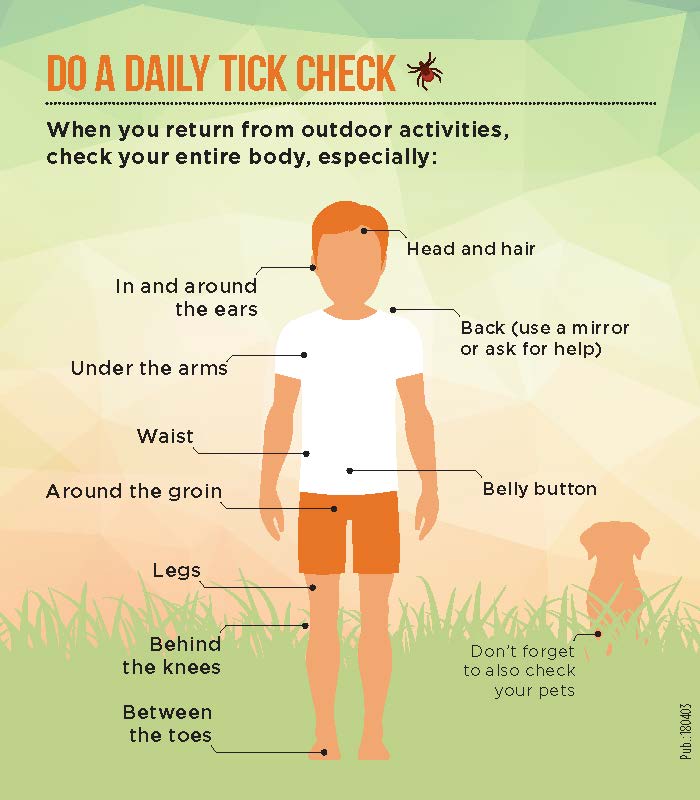Ticks and Lyme Disease
Ticks and Lyme Disease
Ticks are a part of nature and may be found throughout our watershed. They’re more likely to be found in forests, tall grasses, bushes and wet areas with lots of leaf litter. But they can also be carried by birds, raccoons and other animals, meaning they can end up in your backyard too.
Lyme disease is an illness spread through the bite of a black-legged tick – also known as a deer tick – that’s infected with the Borrelia burgdorferi bacteria.
Not all ticks are black-legged ticks, and not all ticks are infected with the bacteria, so not all tick bites spread Lyme disease.
Need some help identifying a tick? Check out this tick identifier guide.
Where are Ticks?
Black-legged ticks are spreading to new areas of the province because of climate change. They can also spread by traveling on birds and deer. While the probability is low, it’s possible to find an infected tick almost anywhere in Ontario.
If an infected black-legged tick is found at one of our Conservation Areas, we’ll publish a notice on this webpage and the Conservation Area page. We will also post signage in the trailhead kiosks at the property.
When are they active?
Ticks are most active in spring and summer, but can be found at any time of the year when the temperature is above freezing.
Public Health Ontario monitors black-legged tick populations within Ontario and publishes an estimated Lyme disease risk area map each year identifying areas within Ontario where infected black-legged ticks have been found. Public Health will continue to monitor for black-legged ticks at various locations across the watershed, and it’s their mandate to provide this information.
Enjoy the Outdoors Safely
With a little preparation, you can always enjoy the outdoors!
- Wear long sleeves and pants, and tuck your pants into your socks and your shirt into your waistband
- Wearing light-coloured clothing (this will make it easier to see them)
- Stay on marked trails
- Use bug spray with DEET or icaridin
Take a look at this video and these nature explorers will teach you how to enjoy the outdoors safely.
Do a thorough Tick Check
The best way to do this is to remove all clothing and look for ticks. You can run your hands over your skin to find any that are embedded. Some people find ticks tickly when they are walking around on their skin, or itchy when they are embedded, so that can make them easier to find, but don’t rely on feeling them. Look carefully!
It’s also good practice to brush off all your clothing and gear before getting in your car or venturing around back at home.
Visit Health Canada for more information on how to do a daily tick check
Ticks and Pets
It’s also important to check your pets regularly for ticks. Although they cannot spread Lyme disease, dogs and cats can bring infected ticks into your home.
If you find a tick on your pet, take it to your vet for identification. Limit their exposure by never letting them roam off-leash unless at a suitable off-leash park. Check your pet for ticks periodically, and discuss options for tick prevention, like tick collars, with your veterinarian.
What about other biting insects?
Biting insects can make the outdoors seem like a scary place. And few people have any fondness towards mosquitoes, ticks, spiders, wasps, ants and many creepy crawlies that can make the enjoyment of the outdoors uncomfortable. It’s important to remember that these bugs are the dinner menu for many of our birds and mammals, and are a necessary part of nature.
Don’t let them keep you inside – not getting fresh air and enjoying your local greenspaces carries risks too, especially on mental health and wellness. What we can do are take steps to reduce our our risk from bites of the insects that carry diseases, same as we take care of ourselves from the sun.
So you found a tick! Now what?
Don’t panic! Know that not all ticks are black-legged ticks, and not all black-legged ticks carry Lyme disease.
Those that do must be attached to a human for a period of 24 to 36 hours before the disease is transmitted.
Need more information?
Get the tick tested
If you’ve found a tick on your body, take it to your health care provider or local health unit.
They will identify if it is a black-legged tick and it will be tested for Lyme at the Ontario Public Health Laboratory.
Only ticks removed from humans will be accepted by the Ontario Public Health Lab.
The following locations accept ticks for testing:
- Simcoe Muskoka District Health Unit (Offices: Cookstown, Barrie, Orillia, Huntsville, Midland, Gravenhurst, Collingwood)
- Durham Region Public Health (Offices: Whitby, Port Perry)
- Haliburton County and City of Kawartha Lakes (Offices: Haliburton, Lindsay, Port Hope)
- York Region (Offices: Newmarket, Markham, Richmond Hill, Vaughan)


